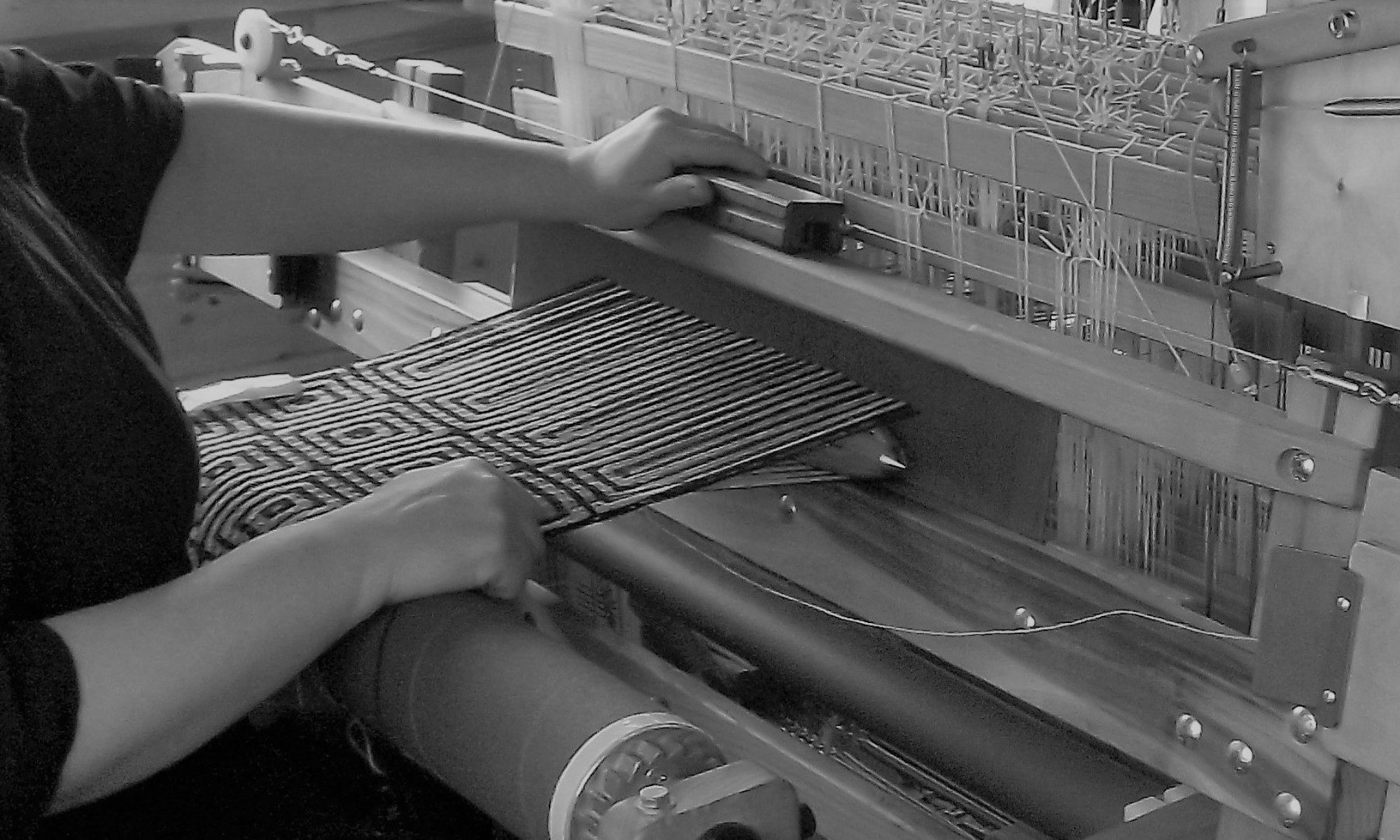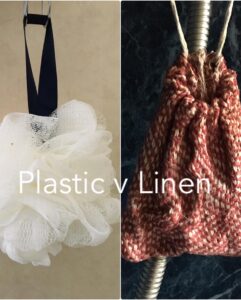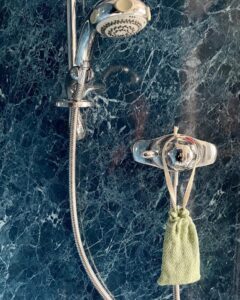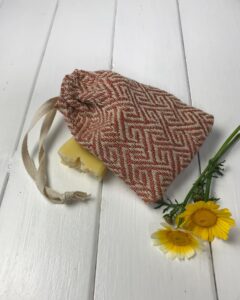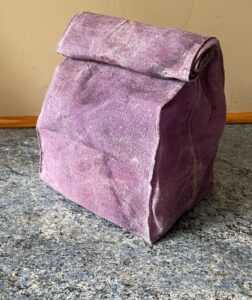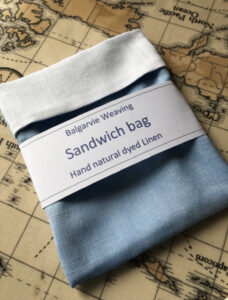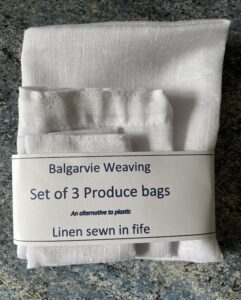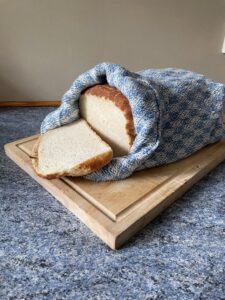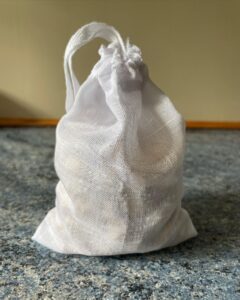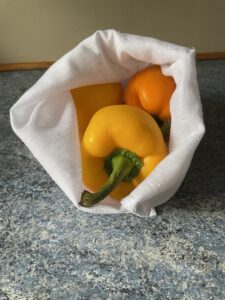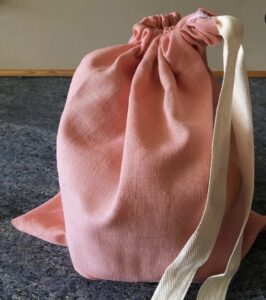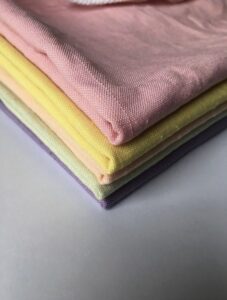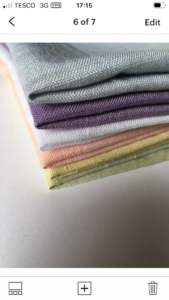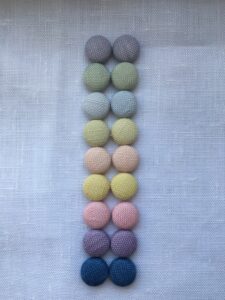Y LINEN :- is a range of utilitarian homewares designed and made by Janet Hughes as Balgarvie Weaving as a direct response to our collective reliance to non sustainable products in our everyday lifestyle.
Linen is a natural cellulose fibre made from the Flax plant.
This amazing plant has wide and varied uses, its naturally antiseptic strong and moisture absorbent.
It has been used by humans since the earliest times.
It is easy to grow and is not resource hungry as it does.
Flax’s pressed oil is used as flooring in hospitals in the form of linseed in linoleum, course fibres are perfect for shipping rope as hemp and sacking as jute, any waste is used as nutritious animal feed.
Y linen range – is made to ask the question WHY should we chose to buy and use linen products.
We are all aware that our over reliance on plastics from oil and shale gas is not only a waste of the planet’s resources in both production and use but we do not dispose or recycle these in a mindful way.
Choosing to use a linen as an alternative to say a plastic bag is not only “good for the planet” but is a multi functional product to be used time and time again. It’s a joyful thing to use and reuse, pleasure being gained by thinking mindfully, feeling good about the process and the product, the act of deliberately being conscious about how we contain our foodstuffs, reducing the amount of toxins that enter our food and so our and our families own food chain can only be a good thing for our health. As more people become aware the collective healing of our planet grows. It all starts with that one person choosing to make a change. Y Linen wants to help that change.
Y Linen range – is a celebration of linen. YES Linen. Say Yes to linen. Yes I want to be that person who has chosen to make that change and use linen everyday.
Y linen is a multi product range using sustainable methods of construction.
Firstly- By hand loom weaving on traditional wooden hand looms. Using zero waste/surplus linen yarn (when a weave designer/ production manager calculates the amount of yarn needed to full fill an order in industry, they always make more available just in case there is always 1/2 cones perfectly good surplus maybe in a non repeatable colour or thickness to the rest of their production that once lay about in boxes or went into landfill. I aim to make this yarn useful) In the handloom craft with me, as the weaver, I hand throw the weft yarn across the warp, as a skilled weaver, I can choose the colours and “use up” any small lots of yarn playing artistically with colour, texture and weave structure, reinventing little used weave structures for a modern contemporary cloth.
This resulting cloth made ”in the whole” with substantial selvedges – the weft yarn is not cut at the edged but turns around to pass back over the warp again and again making a strong edge that doesn’t need folding and sewing. It is a slower progress but one full of purpose as me, the weaver, has intention with every pick weft thrown. This cloth makes exceedingly good towels. Please examine your current towels and you will recognise this stitched mass production. Y linen range includes large bath, spa towels, everyday hand towels (that look great in any contemporary kitchen or bathroom), wash cloths – the mindful reworking of the traditional dish or face cloth and the use again ethos I grew up with (I was taught, as a child, to knit or crochet utilitarian “use, wash and use again cloths” for the home these traditions should be promoted again in this modern world), and super cool soap bags – my favourite product I use everyday. The naturally antibiotic linen doesn’t harbour mould so perfect not an alternative but an improvement to plastic scrubbies, pop either a handmade or commercial bar (or indeed end bits you usually throw away) into the bag, draw the string and hang up in your shower or bathroom and use as an exfoliating self soaping wash cloth or even dry, use, to transport your bar soap on travel trips instead of a liquid soap in a plastic bottle, dual purpose! The open hand loom woven fabric I weave with reinvented traditional, little used, weave structures is a perfect solution – every household should have one.
Secondly- By natural dyeing commercial woven linen. Fine linen (too fine to be commercially viable by handloom) is dyed using natural plant roots, leaves and skins so vegan, no animal (crushed Beatles) used like some natural dyers and above all no harsh chemicals all natural. I learned dying techniques as part of the industrial textile design degree I studied in my 20s. So utilising learned skills I dye in lengths of 1m no more on my kitchen stove. I am mindful of the amounts of water and chemicals I use so dye subsequent batches – the result is a lighter shade that I personally think is aesthetically still pleasing and far to good to simply throw away as its not the same exact shade as the first batch. (we all need to stop thinking of a uniform mass produced product is the only one to own and use) I exhaust the dye bath completely getting at least 4 dyes from each pot so no bad chemicals in the water course, I rinse all colours together in an environmentally high rated domestic washing machine at 60 degrees rendering them safe to used at home for all – any micro fibres that do make it into the water treatment system are both naturally biodegradable and non toxic.
These fabrics I now sew (I was apprentice to a Savile row trained Taylor back in the day) I understand small scale production sewing. I use pure cotton thread, linen not being available its a tolerable alternative to synthetic polyester threads. I make high quality sandwich, bread and produce bags. These bags are not only an alternative to plastic wrapping our foodstuffs they actually enhance the food. They let the food breathe not trapping the gasses ie eliminating the Co2 that speeds up rotting by letting it escape through the permeable linen. The produce bags can also be “dampened” fresh veggies placed in the bottom of the fridge. The salads keep fresher for longer !! Bread bags are a beautiful storage solution. Bento bags are perfect enhancement to your weekly shopping fill these up instead of those single use plastic bags widely available in your local supermarket, weighing only a gram or so and of course modern scales have the ability to weigh your bags first or ask your grocer to “fill your own bag”.
Another product I make is wax wraps. I apply a special finish (again learnt as part of my degree) to my naturally dyed fabric of locally sourced beeswax and imported sustainable pine resin from Europe to make the perfect wrap for your cheese etc.
My personal ethos is that I make products I want to use and just make more than I need to make these things available to others to buy and use. Making good use of my given talents to benefit others.
Linen V other fibres
Linen is a natural fibre, that is it is not chemically extracted from say North Sea Oil it grows, a living plant that reoxygenates its environment through photosynthesis.
Linen thrives on poorer soil conditions than say Cotton, which is VERY water hungry please to take the time to look into the Arel Sea in .https://blog.nationalgeographic.org/2014/10/14/what-the-disappearing-aral-sea-tells-us-about-the-value-of-water/..so kinder to our blue planet as well and not compounding a social and economic downfall.
To make linen yarn from flax the plant fibres need to be thrashed to separate then spun with a characteristic slub(thick and thin bits) maybe plyed (two or more twisted together). This process is far simpler than say from regenerated Soya, Bamboo or wood (viscose), which while still being made of cellulose fibres and marketed as “good eco fibres” these are processed with chemicals and then extruded in a similar resource thirsty way to true synthetic yarns we are all familiar with in our modern life.
Linen is THE traditional fibre woven in my home kingdom of Fife here on the east coast of Scotland. Infact the row of traditional houses in my road were once “weavers cottages” you can still see the post holes in the walls where the benches for the looms were once connected to the buildings.
This is WHY I have said YES to LINEN.
Y LINEN range was born out of my passion for weaving and utilising the great properties of linen and my hope that other folk will use it too.
